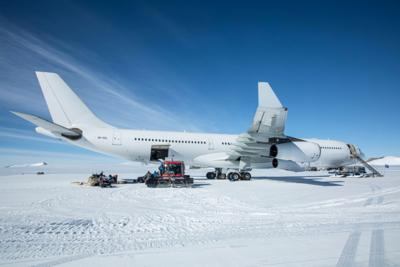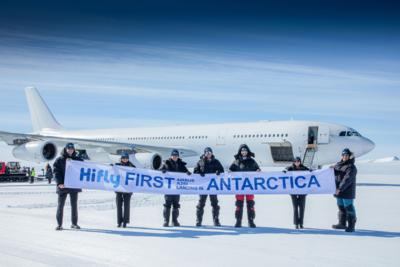Hi Fly Lands On Runway Hewn From Ice In Aeronautical First
Hi Fly, a widebody aircraft wet lease specialist, made their mark on Airbus history on November 2, 2021 when they landed their A340-313HGW on an Antarctic blue glacial ice runway.

Flying from Cape Town, South Africa, to the Wolf’s Fang Runway, Antarctica, the aircraft began its seasonal service flying tourists, scientists, and essential cargo to the desolate, isolated region. With a few preparations, the 4 engine, high gross weight aircraft can ferry all the necessities for the region with its maximum gross takeoff weight of 275 tons. For those effectively stranded at the ends of the earth, that cargo capacity is gratefully accepted, bringing with it mail, fresh faces, and sometimes eagerly anticipated online orders. Describing their initial operations flying south, Hi Fly released their Captain's log outlining the work that goes into flying into one of the most inhospitable locales on Earth.
The flight south brought the necessary ground support equipment needed for their season of work at Wolf's Fang, as well as 23 passengers headed down to the ice. The 2500 nautical mile flight took a bit over 5 hours each way as the flight completed two test sorties to double check their route, infrastructure, and preparation. Without fueling facilities on the ice, 77 tons of fuel for the return trip had to be maintained after the inbound leg, a quantity that would be excessive on nearly any other mission. Landing weight at Wolf's Fang could not exceed the max of 190 tons, a fact made all the more important when landing on a runway carved out of almost 9/10ths of a mile sheet of ice. The Captain noted that station personnel approached the Airbus landing with some anxiety, but Hi Fly was confident in the quality of preparation and calculation they had planned out.

The flight south brought with it some interesting caveats, such as the last 250 miles of comm-free flying to the airport, bereft of CPDLC/ADS coverage and reliant upon closing with the antarctic VHF stations. Once the aircraft passed south of 65 degrees, polar navigation techniques take effect and true heading is used as the reference. With traditional plotting and navigation, weather reports passed through the ground crew's Iridium satphone uplink, the A340 made its way successfully into its landing approach.
With the intense glare from the wide, omnipresent span of reflective ice, special care must be taken for eye protection and instrumentation viewing. Bereft of any navigation aids, glideslope indicators, or anything more advanced than a Mark I eyeball, the crew exercised their skill and care in hand-flying a textbook approach. The crew landed and prepared their cold weather gear and ground equipment for the journey outside, greeted the locals, and took a moment to gather around to commemorate the occasion. With everything in place, Hi Fly will continue service to the station down south, undoubtedly a pleasant boon to those so distant from human settlement.
 ANN's Daily Aero-Term (12.01.25): Convective SIGMET
ANN's Daily Aero-Term (12.01.25): Convective SIGMET ANN's Daily Aero-Linx (12.01.25)
ANN's Daily Aero-Linx (12.01.25) NTSB Final Report: Remos Aircraft GmbH Remos GX
NTSB Final Report: Remos Aircraft GmbH Remos GX Aero-News: Quote of the Day (12.02.25)
Aero-News: Quote of the Day (12.02.25) ANN's Daily Aero-Term (12.02.25): Coupled Approach
ANN's Daily Aero-Term (12.02.25): Coupled Approach




